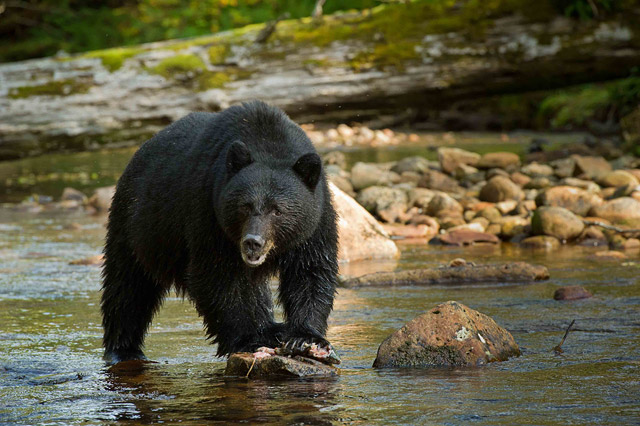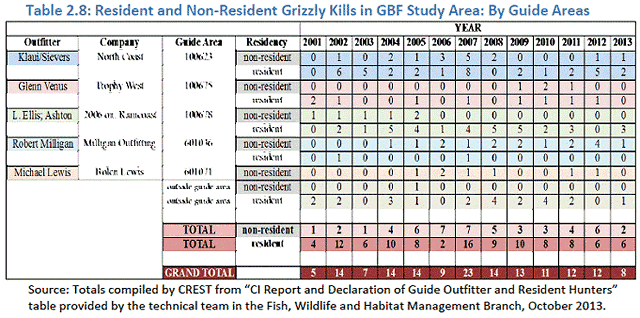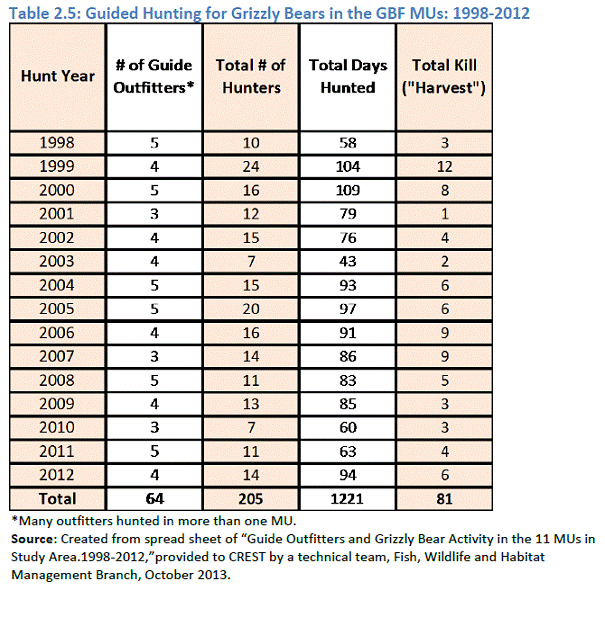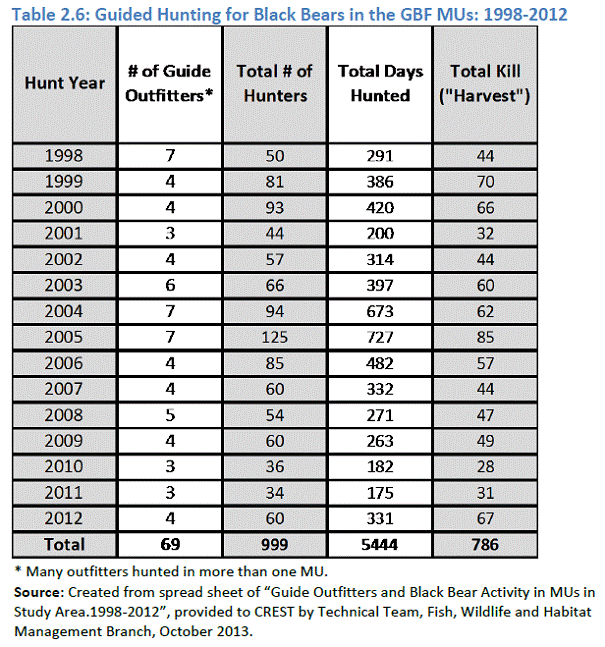|
| |
| 19. Januar 2014 |
Umweltschutzgruppen versuchen weitere Jagdlizenzen im Great Bear Rainforest
aufzukaufen, um hierüber die Trophäenjagd eindämmen zu können |
| |
| „Ecogroups hope to oust bear-hunting guides from rainforest“, lautete der Titel eines Artikels von Mark Hume in The Globe and Mail vom 8. Januar 2014. „Environmental groups are hoping to launch a major fundraising campaign in the near future to raise millions of dollars to put bear-hunting guides out of business in the Great Bear Rainforest“, schrieb Hume. Nach Veröffentlichung der Studie „Economic Impact of Bear Viewing and Bear Hunting in The Great Bear Rainforest of British Columbia“ des Center for Responsible Travel (CREST) am 7. Januar 2014 stehen die Trophäenjagdveranstalter stark unter Druck und versuchen offenbar bereits, ihre Jagdlizenzen an Umweltschutzorganisationen zu verkaufen. Durch Ankauf dieser Jagdlizenzen und bewusstes Nicht-Ausüben der Jagd soll das Töten von Bären, Wölfen, Pumas und anderen großen Beutegreifern durch ausländische Trophäenjäger oder Jäger aus anderen kanadischen Provinzen gestoppt werden. Brian Falconer von der Raincoast Conservation Foundation bestätigte, dass es bereits Gespräche mit vier Inhabern von Jagdlizenzen im Great Bear Rainforest gibt, die eventuell verkaufen möchten. „We’re talking to four right now and they are the major guides active in the area. Ultimately, we’d like to buy out all the hunting guides in the Great Bear Rainforest.“ Brian Falconer räumte ein, dass dies viele Millionen kosten würde: „There’s no question it will be a fundraising challenge … but we’re optimistic.“ Bisher allerdings zwingt die Provinzregierung von BC die Inhaber einer Jagdlizenz dazu, vom Jagdrecht auch tatsächlich Gebrauch zu machen, d. h. z. B. Bären zu erlegen. Geschieht dies nicht, so kann theoretisch demjenigen, der sein Jagdrecht nicht ausübt, die Jagdlizenz wieder entzogen werden oder das Recht, Bären zu töten, wird auf andere, einheimische Jäger übertragen. Diese paradoxe Situation muss deshalb vor dem Ankauf neuer Jagdlizenzen durch Umweltschutzorganisationen noch geklärt werden. „The policy is basically that you have to kill some bears, but there’s an opportunity for the government to make an exception for this area and we are hoping to arrange a meeting with the minister to discuss that“, sagte Brian Falconer. |
| |
 |
| Schwarzbär mit erbeutetem Lachs |
© Klaus Pommerenke |
|
| |
| Al Martin vom Jagdverband B.C. Wildlife Federation hat im Prinzip nichts gegen den Verkauf von Jagdlizenzen an Umweltschutzgruppen: „It’s a free market … that’s a business transaction“, meinte er. Er hat längst erkannt, dass die Trophäenjagd von einer Bevölkerungsmehrheit ethisch geächtet wird, sie als unmoralisch betrachtet wird und auch unökonomisch ist. Selbst Scott Ellis, Direktor der Guide Outfitters Association of BC, bisher ein Hardliner ohne jede Kompromissbereitschaft mit besten Beziehungen ins Ministerium, scheint jetzt immerhin eine Koexistenz von Jagd- und Ökotourismusveranstaltern anzustreben. „We really need to find a way to share the resources“, erklärte er. |
| Bereits im Juli 2005 hatte die Raincoast Conservation Foundation die Jagdlizenz über ein 24.700 km² großes Gebiet im Great Bear Rainforest erworben. Leonard Ellis von Bella Coola hatte damals seine fünf zusammenhängenden Jagdgebiete für 1,35 Millionen CAD verkauft. Im August 2011 gelang es der Raincoast Conservation Foundation nach einer Spendenkampagne für 370.000 CAD das sogenannte Spirit Bear Hunting Territory mit einer Größe von 3.500 km² (Landgebiete alleine) von Michael Lewis zu erwerben. Es umfasst das Kerngebiet des Spiritbär-Lebensraumes mit den Inseln Princess Royal, Gribbell, Gil, Campania, Aristazabel und die Estavan Group, jedoch leider keine Gebiete auf dem Festland. Trotzdem konnte die bisher bestehende Schutzgebietszone auf eine Größe von 28.200 km² erweitert werden. |
| Durch den Ankauf der Jagdlizenz von Leonard Ellis (Guide Area 100678) wurde von ausländischen Trophäenjägern in diesem Gebiet seit 2006 kein Grizzlybär mehr getötet. Da das Ministerium die Jagd für die Einwohner von BC jedoch nach wie vor erlaubt, kam es zur Tötung von 23 Grizzlybären. |
| In der CREST-Studie heißt es hierzu: „The purpose of the buy-outs is to stop the non-resident grizzly bear hunting in these areas of the GBR [Great Bear Rainforest]. However, Raincoast and its allies state that their ultimate goal is to stop trophy bear hunting completely by both non-resident and resident hunters. As Table 2.8 shows, in Raincoast’s Guide Area 100678, no grizzlies were reported killed by non-resident hunters after 2005. However, resident hunting has continued in this Guide Area, with 23 grizzlies killed by resident hunters between 2006 and spring 2013. In a memo prepared for CREST, the MFLNRO [Ministry of Forests, Lands and Natural Resource Operations] technical team stated, ‚The purchase of the guide outfitting territory did not effectively stop hunting within that area.‘ The memo explained that ‚the operations within a guide outfitter territory do not limit or restrict non-guided [resident] hunters within that area. Through the purchase of that territory Raincoast had the option to reduce the number of guided hunters within the area but did not have any authority to reduce or eliminate opportunities for non-guided [resident] hunters‘. While the government contends that it has the legal authority to reallocate any of these unused non-resident hunting tags (specie licenses) to resident hunters, the Management Branch technical team stated that so far this has not happened for the territories purchased by Raincoast. |
| |
 |
| |
| Responding to the government’s position, Chris Genovali, Executive Director of Raincoast Conservation Foundation, stated, ‚Raincoast purchased the guide outfitting territory to control the commercial trophy hunting in this vast area. The resident hunt is a completely separate issue and we had no expectation of reducing it by carrying out this acquisition.‘ Brian Falconer, Guide Outfitter Coordinator for Raincoast, added, ‚While there were 23 grizzly bears killed by resident hunters in this territory during this 8 year period [2006 – 2013], Raincoast had an annual quota of 5 bears per year – a total of 40 bears – which we did not kill.‘ |
| While the buy-outs have successfully reduced non-resident hunting, there remains considerable bear hunting throughout GBR, mainly by resident hunters. Overall, according to CI [Compulsory Inspection] data in Table 2.8, between 2001 and 2013, resident hunters killed more than twice as many grizzlies as non-resident hunters (102 vs. 50) in the GBF study area. In 2013, the resident hunt within Raincoast’s territory erupted into a public scandal when it was revealed that a National Hockey League (NHL) player shot and killed a grizzly bear known locally as ‚Cheeky‘. Initially questions were raised whether the hockey player should have been given a resident hunting license since he now lives in the United States. More broadly, for those opposed to bear hunting, this incident again highlighted the need to stop resident bear hunting as well. As one of those involved in buying out guide outfitters explained, ‚This type of hunting should be stopped, but the resident hunter lobby is politically powerful in BC. And because there are so many, we can’t buy them out like we can guide outfitters‘. |
| With the Coastal First Nations declaration of a ban on all types of bear hunting in 2012 and the growing public opposition to bear hunting in the GBF [Great Bear Rainforest], the remaining guide operators in the GBF are sensing the writing on the wall. Some have diversified to offer other outdoor sports activities such as fishing and wildlife-viewing. One outfitter wrote in responding to the CREST survey that half his income came from ‚non-hunting activities‘. He said that he expects his hunting business to continue to decline. He blamed mainly not the Coastal First Nations trophy-hunting moratorium but the ‚fierce competition from USA hunting outfits for bear which have lower costs and less restrictive hunting regulations‘. Other hunters surveyed and interviewed blamed ‚the politics of grizzly hunting [that] forecloses the opportunity to hunt‘, falling salmon stocks which is causing a decline in the grizzly population, or the BC governments’ ‚rough guesstimates‘ of the real size of grizzly population. As one hunter put it, ‚I don’t think the government’s got an accurate handle on any game in BC. I think there was a significant drop in grizzlies in 2008-2009‘ and ‚too many tags were issued on the Central Coast‘. For what is apparently a mix of reasons, by late 2013, the remaining guide operators in the GBF were said to be quietly approaching conservation organizations to discuss selling their territories. According to Raincoast, ‚We are in conversations with several guide outfitters at this point and we are interested in purchasing these territories.‘“ |
| Allein in den 11 Jagdbezirken des Great Bear Rainforest wurden im Zeitraum von 1998 bis 2012 81 Grizzlybären von Trophäenjägern getötet (vgl. Tabelle 2.5 der CREST-Studie) und 786 Schwarzbären (vgl. Tabelle 2.6 der CREST-Studie). Die Tötungszahlen von drei Jagdbezirken (Wildlife Management Units), die zu mehr als der Hälfte außerhalb des Gebiets des Great Bear Rainforest liegen, sind hierin nicht enthalten, auch nicht die vermutlich hohe Zahl illegal getöteter Bären durch Wilderer. |
| |
 |
| |
 |
| |
 zurück zurück |
|
|

